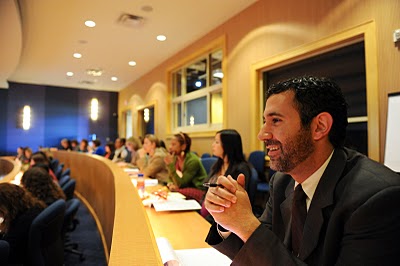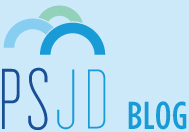Pursuing a Public Interest Career: Key Insights from NALP/PSLawNet Public Service Mini-Conference and EJW Conference and Career Fair (Part 2 of 2)
Today’s guest post is shared by Leeor Neta, the Assistant Director for Public Interest Programs at Golden Gate University School of Law. After attending the 2010 NALP/PSLawNet Public Service Mini-Conference and EJW Conference and Career Fair he is sharing key insights from programming he attended at both conferences on GGU’s Law Career Services Blog. (Read Part 1)
 Finding and Making the Most of a Mentor
Finding and Making the Most of a Mentor
On the last day of the conference, I attended a session on how to find and maintain a mentor relationship. The speaker explained that there are three ingredients to successful mentorship: (1) reasonable expectations, (2) a strategic approach, and (3) a two-way relationship.
In order to ensure that one’s expectations are reasonable, mentees should ask themselves specifically what they are hoping to get out of the relationship. The mentor relationship cannot just be designed to find the mentee a job, but it can be designed to help the mentee acquire skills, act as a sounding board for the mentee, and offer answers to specific questions the mentee might have. Because no one mentor can do everything, mentees should “build a board of mentors”, each one of whom is available to provide advice and support on a specific topic.
Finding multiple mentors requires some strategic thinking, and that means planning where to find mentors and how to approach them. Everyone agreed that students need to create LinkedIn profiles and use keyword searches to identify potential mentors. Indeed, one of the attorneys in attendance confessed that she found a job through her LinkedIn profile.
Once a mentor is found, the mentee needs to make sure that the relationship remains “a two way street.” What that means is that mentees need to think about what they bring to the relationship — whether it be a certain kind of energy, a different perspective, or even knowledge about social media advocacy — and offer themselves as resources to their mentors.
Student Debt Relief
The Equal Justice Works (EJW) Conference also featured a lengthy presentation on student debt relief. For many years, most law school graduates that decided to pursue public interest careers had a very difficult time paying back their student loan debt. In the last few years, however, the Public Service Loan Forgiveness Program (PSLF) has made it much easier to manage that debt. In fact, PSLF has made it so easy that, according to EJW’s expert on student debt relief, Heather Jarvis, “it is better financially in terms of debt relief to go into public service.”
PSLF was created by the College Cost Reduction and Access Act of 2007. As Heather often repeated in her presentation, to qualify for PSLF, a person must “make the right kind of payment on the right kind of loan while in the right kind of job.” After 120 qualifying payments, one can apply for and receive forgiveness of the remaining debt.
So what is “the right kind of payment on the right kind of loan while in the right kind of job”?
The “right kind of payment” is referred to as income-based repayment (IBR). IBR is different from a term loan of 10 years or 30 years because it is not calculated to be paid off in a finite period of time; IBR is calculated based only on one’s adjusted gross income. As a result, IBR is significantly less than most 30-year term plan payments. IBR is for everyone regardless of whether one is working in public service. For married couples, both spouses’ debt as well as their income will be considered for purposes of determining the IBR payment. You can determine your IBR payment by going to http://www.ibrinfo.org/ and www.finaid.org/calculators/ibr.phtml.
The “right kind of loan” for purposes of PSLF is a Federal Direct loan. It also includes Grad Plus, FFEL, Perkins and Stafford loans if consolidated with federal direct loans after graduation. The only loans that are NOT included are commercial or alternative loans, Parent PLUS loans, late payments, and loans that are currently in default. Even if some of your debt was incurred before 2007 (when PSLF was created), you need only to reconsolidate under Federal Direct in order to avail yourself of PSLF. You can find out what kinds of student loans you have by going to http://www.nslds.ed.gov/.
The “right kind of job” for purposes of PSLF is work for a government, 501(c)(3) charitable non-profit organization, Americorps, Peace Corps or most other public service organization. The definition is so broad that the only kind of work that is probably NOT included is for-profit sector work, international work, contract work, or work for labor unions. The work must be paid and “full time.” “Full time” means whatever the organization says it means or at least 30 hours per week. The work does not need to be legal, though one needs to be in the qualifying employment when forgiveness is granted.
The best part about IBR is that one can still qualify for loan forgiveness after 25 years, even if one leaves public service, if their income remains low enough for them to qualify. However, if one makes 120 IBR payments while in public service, her debt will be forgiven in just 10 years.
Heather also provided some brief information about two other programs: the Civil Legal Assistance Attorney Student Loan Repayment Program (CLAARP) and the John R. Justice Program. CLAARP reimburses a portion of eligible federal student loan debt for civil legal assistance attorneys—$6,000 per attorney per year to a maximum of $40,000. John R. Justice reimburses a portion of eligible federal student loan debt for district attorneys and public defenders—$10,000 per attorney per year to a maximum of $60,000. Both programs require a 3-year service agreement.
Equal Access to Justice
One of the more inspiring presentations during the Equal Justice Works Conference was a discussion between Professor Laurence Tribe and Judge David Tatel on equal access to justice. Professor Tribe was appointed the Senior Counselor for Access to Justice at the US Department of Justice in March 2010.
In discussing his efforts to develop programs that address the justice gap, Professor Tribe admitted that there is no way that everyone who needs representation can get it. But he said that we, as lawyers and aspiring lawyers, need to ensure that we empower people to represent themselves whenever and however possible, e.g., through self-help initiatives.
Professor Tribe called for a greater commitment of resources to equal access to justice initiatives, and explained that Congress needs to be persuaded that they can save money by spending more money. Professor Tribe specifically addressed the need to support juvenile diversion and homelessness intervention programs. In the long run, he said, we need a much more stable source of funding for indigent civil and criminal representation. Law firms also need much more stringent pro bono guidelines, signature pro bono projects and institutions to reward pro bono service.
Turning to law schools, Professor Tribe pointed out that law schools tend to focus too much on “law” — a means, sometimes to oppression — and not enough on “justice” — an indisputably important end that sometimes transcends law. When asked what law schools can do now to promote these values, Professor Tribe claimed that law schools need to change, not their curriculum, but the way they are teaching classes. The law school’s leadership, attitude and focus all need to be aligned towards justice. Indeed, he said, we need to stop calling our institutions “schools of law” and instead call them “schools of justice.”













